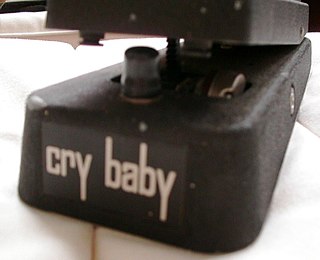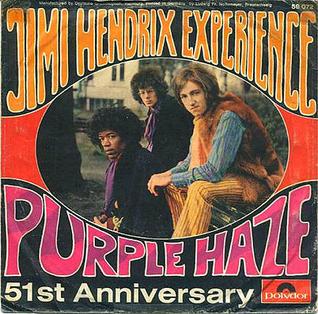Related Research Articles

An effects unit, effects processor, or effects pedal is an electronic device that alters the sound of a musical instrument or other audio source through audio signal processing.

James Marshall "Jimi" Hendrix was an American guitarist, songwriter and singer. Although his mainstream career spanned only four years, he is widely regarded as the greatest and one of the most influential electric guitarists in the history of popular music, and one of the most celebrated musicians of the 20th century. The Rock and Roll Hall of Fame describes him as "arguably the greatest instrumentalist in the history of rock music."

Eric Johnson is an American guitarist, vocalist and composer. His 1990 album Ah Via Musicom was certified platinum by the RIAA, and the single "Cliffs of Dover" won the Grammy Award for Best Rock Instrumental Performance.

A wah-wah pedal, or simply wah pedal, is a type of effects pedal designed for electric guitar that alters the timbre of the input signal to create a distinctive sound, mimicking the human voice saying the onomatopoeic name "wah-wah". The pedal sweeps a band-pass filter up and down in frequency to create a spectral glide. The wah-wah effect originated in the 1920s, with trumpet or trombone players finding they could produce an expressive crying tone by moving a mute in, and out of the instrument's bell. This was later simulated with electronic circuitry for the electric guitar when the wah-wah pedal was invented. It is controlled by movement of the player's foot on a rocking pedal connected to a potentiometer. Wah-wah effects may be used without moving the treadle as a fixed filter to alter an instrument’s timbre, or to create a "wacka-wacka" funk-styled rhythm for rhythm guitar playing.

"Purple Haze" is a song written by Jimi Hendrix and released as the second single by the Jimi Hendrix Experience on March 17, 1967, in the United Kingdom. The song features his inventive guitar playing, which uses the signature Hendrix chord and a mix of blues and Eastern modalities, shaped by novel sound processing techniques. Because of ambiguities in the lyrics, listeners often interpret the song as referring to a psychedelic experience, although Hendrix described it as a love song. It was included as the opening track in the North American edition of the Experience's debut album, Are You Experienced (1967).

Are You Experienced is the debut studio album by the Jimi Hendrix Experience, released in May 1967. The album was an immediate critical and commercial success, and is widely regarded as one of the greatest albums of all time. It features Jimi Hendrix's innovative approach to songwriting and electric guitar playing, which soon established a new direction in psychedelic and rock music as a whole.

Edwin H. Kramer is a South African-born recording producer and engineer. He has collaborated with several artists now in the Rock and Roll Hall of Fame, including Jimi Hendrix, the Beatles, David Bowie, the Rolling Stones, Led Zeppelin, Eric Clapton, the Kinks, Kiss, John Mellencamp, and Carlos Santana, as well as records for other well-known artists in various genres.

Francesco Antonio Marino is a Canadian guitarist and singer, best known as the leader of Canadian hard rock band Mahogany Rush. Often compared to Jimi Hendrix, he is described as one of the most underrated guitarists of the 1970s. In 2021, he announced his retirement from music.
"Little Wing" is a song written by Jimi Hendrix and recorded by the Jimi Hendrix Experience in 1967. It is a slower tempo, rhythm and blues-inspired ballad featuring Hendrix's vocal and guitar with recording studio effects accompanied by bass, drums, and glockenspiel. Lyrically, it is one of several of his songs that reference an idealized feminine or guardian angel-like figure. At about two and a half minutes in length, it is one of his most concise and melodically focused pieces.

Band of Gypsys is a live album by Jimi Hendrix and the first without his original group, the Jimi Hendrix Experience. It was recorded on January 1, 1970, at the Fillmore East in New York City with Billy Cox on bass and Buddy Miles on drums, frequently referred to as the Band of Gypsys. The album mixes funk and rhythm and blues elements with hard rock and jamming, an approach which later became the basis of funk rock. It contains previously unreleased songs and was the last full-length Hendrix album released before his death six months later.

Electro-Harmonix is a New York City-based company that makes electronic audio processors and sells rebranded vacuum tubes. The company was founded by Mike Matthews in 1968. It is best known for a series of guitar effects pedals introduced in the 1970s and 1990s. EHX also made a line of guitars in the 1970s.
Octave effect boxes are a type of special effects unit which mix the input signal with a synthesized signal whose musical tone is an octave lower or higher than the original. The synthesised octave signal is derived from the original input signal by halving (octave-down) or doubling (octave-up) the frequency. This is possible due to the simple two-to-one relationship between the frequencies of musical notes which are separated by an octave. One of the first popular musicians to employ the octave effect was Jimi Hendrix, who also used a variety of other effects in his recordings and public performances. Hendrix used an octave-fuzz pedal known as the octavia.

A fuzz-wah pedal is a stomp box containing both a fuzzbox and wah-wah pedal in series, allowing the user to distort ("wah") and use "fuzz" sounds as aesthetic effects on electric guitar or bass. They were developed to combine the sounds of psychedelic bands of the late 1960s–'70s.

The Dunlop Cry Baby is a popular wah-wah pedal, manufactured by Dunlop Manufacturing, Inc. The name Cry Baby was from the original pedal from which it was copied, the Thomas Organ/Vox Cry Baby wah-wah, first manufactured in 1966. Thomas Organ/Vox failed to register the name as a trademark, leaving it open for Dunlop. More recently, Dunlop manufactured the Vox pedals under licence, although this is no longer the case.

"Machine Gun" is a song written by American musician Jimi Hendrix, and originally recorded for the 1970 Band of Gypsys album, with Billy Cox and Buddy Miles. It is a lengthy, loosely defined (jam-based) protest of the Vietnam War.

The Fuzz Face is an effects pedal for electric guitar, used also by some electric bass players. It is designed to produce a distorted sound referred to as "fuzz", originally achieved through accident such as broken electrical components or damaged speakers.

Distortion and overdrive are forms of audio signal processing used to alter the sound of amplified electric musical instruments, usually by increasing their gain, producing a "fuzzy", "growling", or "gritty" tone. Distortion is most commonly used with the electric guitar, but may also be used with other electric instruments such as electric bass, electric piano, synthesizer and Hammond organ. Guitarists playing electric blues originally obtained an overdriven sound by turning up their vacuum tube-powered guitar amplifiers to high volumes, which caused the signal to distort. While overdriven tube amps are still used to obtain overdrive, especially in genres like blues and rockabilly, a number of other ways to produce distortion have been developed since the 1960s, such as distortion effect pedals. The growling tone of a distorted electric guitar is a key part of many genres, including blues and many rock music genres, notably hard rock, punk rock, hardcore punk, acid rock, and heavy metal music, while the use of distorted bass has been essential in a genre of hip hop music and alternative hip hop known as "SoundCloud rap".

The Octavia was an effects pedal designed for Jimi Hendrix by his sound technician, Roger Mayer. It reproduces the input signal from a guitar one octave higher in pitch, and mixes it with the original and added distortion fuzz.

Vintage musical equipment is older music gear, including instruments, amplifiers and speakers, sound recording equipment and effects pedals, sought after, maintained and used by record producers, audio engineers and musicians who are interested in historical music genres. While any piece of equipment of sufficient age can be considered vintage, in the 2010s the term is typically applied to instruments and gear from the 1970s and earlier. Guitars, amps, pedals, electric keyboards, sound recording equipment from the 1950s to 1970s are particularly sought. Musical equipment from the 1940s and prior eras is often expensive, and sought out mainly by museums or collectors.

The Maestro FZ-1 Fuzz-Tone was the first widely marketed fuzz distortion guitar and bass effect. Introduced in 1962, it achieved widespread popularity in 1965 after the Rolling Stones guitarist Keith Richards prominent use of the FZ-1 on the group's hit, "Satisfaction". Later in 1965 the design was slightly modified, designated as the model FZ1-1a. In the wake of the success of the Rolling Stones' "Satisfaction," numerous recordings mostly from 1960s garage rock and psychedelic acts featured Maestro Fuzz-Tones on guitars. More significant design changes made after 1967 resulted in different renditions of the Fuzz-Tone released over the years. In the 1990s Gibson re-issued FZ-1a, but it was later discontinued.
References
- ↑ Gallagher, Mitch (2012). Guitar Tone:: Pursuing the Ultimate Guitar Sound. Cengage Learning. p. 261. ISBN 9781435456211 . Retrieved 13 September 2014.
- ↑ April 2019, Guitar World Staff 19. "The Secrets of Jimi Hendrix's Guitar Setup: Interview with Roger Mayer". guitarworld. Retrieved 27 August 2020.
{{cite web}}: CS1 maint: numeric names: authors list (link) - ↑ September 2019, Jonathan Horsley19. "Jimmy Page talks about Roger Mayer bringing the distortion pedal into his life". MusicRadar. Retrieved 27 August 2020.
{{cite web}}: CS1 maint: numeric names: authors list (link) - ↑ "Roger Mayer awarded 'Innovator of the Year'". guitarvillage.co.uk. Retrieved 17 August 2020.
- ↑ Guitar, Vintage (3 December 2018). "2018 Readers' Choice Awards". Vintage Guitar® magazine. Retrieved 27 August 2020.
- ↑ Reverb , 8 Jan 2018 - Interviews, Hendrix, Page, and Standing Out in a Crowded Effects Market: A Conversation with Roger Mayer by Jake Law
- ↑ "Jimi Hendrix | An Interview with Michael Fairchild". starting-at-zero.com. Retrieved 27 August 2020.
- ↑ AnOther (13 September 2010). "Roger Mayer, sound engineer, on his friend Jimi Hendrix". AnOther. Retrieved 27 August 2020.
- ↑ "Masterclass: Roger Mayer". BIMM. Retrieved 27 August 2020.
- ↑ "Tom Principato | Biography & History". AllMusic. Retrieved 27 August 2020.
- ↑ Thomas, Bryan (27 November 2017). "Jimi Hendrix: By Those Who Knew Him Best". Nightflight.com. Retrieved 25 June 2023.